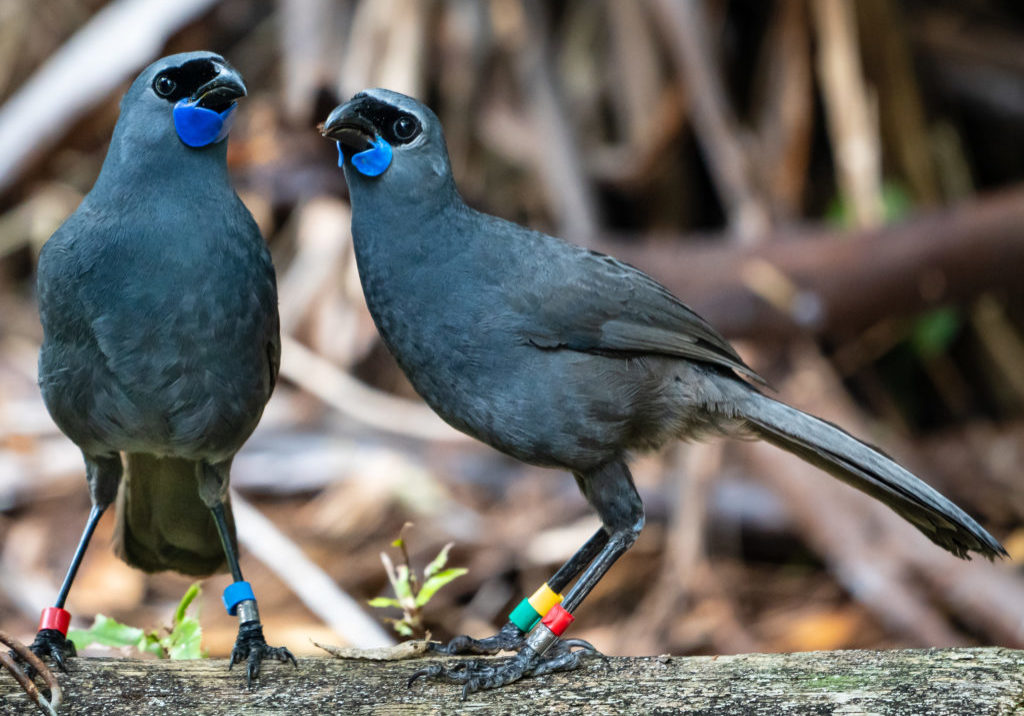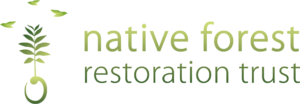Mangatutu and Tunawaea kokako project

Photo by Bernie Krippner
Background:
This project has evolved from the initiative that saw the protection of Rangitoto Station by the Restoration Trust. The purchase of this property has provided increased opportunity and involvement by members of the Restoration Trust, the Otorohanga Zoological Society and public generally in active, on the ground conservation management, including predator control, to enhance the survival of endangered fauna. At the instigation of trustee Arthur Cowan, active management in the form of a minimum bait station operation commenced in the Mangatutu Ecological Area in 1993 involving trustees Roy Dench and Bob Horsfall. Both have considerable local knowledge and were aware of a reasonable kokako population that existed within the area.
In 1995 trustee Laurence Gordon, armed with this initial information, promoted an intensive and extensive predator control operation (possums and rats) to the Department of Conservation and Environment Waikato in an effort to obtain funds for the operation. With support from these organisations as well as the State Norwich Kokako Recovery Fund, the Otorohanga Zoological Society, the Native Forest Restoration Trust and the Waikato Branch of the Royal Forest and Bird Protection Society, the project commenced on the 1st of August 1995. The NZ Lottery Grants Board has also assisted with funding for bait.
Kokako Populations:
The endangered kokako is a bird of ancient lineage related to the saddleback and now extinct huia. There are an estimated 1200 – 1400 birds still remaining, and populations continue to decline in areas without predator control. The kokako is a weak flier. With its strong legs it moves through the forest by springing from branch to branch, using its rounded wings to maintain balance and to glide between trees.
Kokako are mainly vegetarian, their diet varying with the seasons. In late summer and autumn they feed on foliage and fruits of podocarp and hardwood trees and on berries from a variety of shrubs and vines. They eat insects during the warmer months and especially when chicks need to be fed on the richer protein diet.
Although kokako often feed on the forest floor, they are usually difficult to see as they spend much of their time hidden in the canopy of tall trees. They are renowned for their hauntingly beautiful song which consists of long, mellow, euphonious notes followed by clear flute-like passages and repeated clucks and mews. The song is best heard just after dawn. The birds are long-lived, possibly reaching 25 years.
There are two significant kokako populations near Rangitoto Station, one in the Mangatutu Ecological Area and the other in the Tunawaea valley. Rangitoto Station Reserve provides a link between these two areas. There are over 150 birds in the Mangatutu and over 30 in the Tunawaea, but monitoring is incomplete. In 1995/96 at least 10 juveniles were known to have fledged, and in 1996/97 at least 15. As birds are not fitted with transmitters it is not possible to locate all birds each year.
In 2001, due to lack of funding, Laurence was unable to continue, and the project was maintained through volunteer effort. The Trust is hopeful a more permanent source of funding can be found.
Predator and Browser Control:
The aim of the project is to provide practical, low-cost predator control to enable the survival of kokako and all other indigenous species in the area. The area covered by bait stations is gradually being extended, with about 1,400 hectares in the Mangatutu and Tunawaea being covered in 1997/98.
The main predators are rats and possums whose numbers have been kept relatively low in the past by aerial 1080 drops for TB control. Generally, bait stations are placed at 50 metre intervals around the periphery and at 100 metre spacings along ridges. The bait used is Talon. Possum numbers are checked by a trapping procedure, and rats by tracking tunnels where paw imprints indicate their presence.
The kokako diet overlaps with that of introduced browsers such as possums, goats and deer. As a result of aerial 1080 carrot drops in the winter of 1996 there has been a noticeable reduction in deer and pig numbers. This has led to a resurgence of plants that were previously present in very low numbers. These include pate, hangehange, puka and Coprosma grandifolia. These plants are important in the kokako diet, especially for feeding of juveniles, and it stresses the need to keep deer numbers as low as possible. Goats are culled regularly by the Department of Conservation.
Benefits for other Fauna:
The project aims to restore not only kokako populations, but also that of all other native birds in the area. The forest surounding Rangitoto Station Reserve is abundant in native wildlife which has also benefitted from the predator and browser control. Other threatened species recorded in the area are the brown kiwi, of which 4 have been recorded, a breeding pair of falcon, blue duck and kaka. Native pigeons are becoming more numerous, as are bellbirds, robins, whiteheads, tui, pied tit and fantails. Kakariki and the rifleman have been recorded in recent years, but sightings have been few. Generally bird numbers appear to be increasing and this is confirmed by the amount of bird song heard in the forest.
Volunteer Involvement:
The house on Rangitoto Station provides a base for paid workers and volunteers. The latter have been invaluable in assisting with predator control and locating kokako nests. Volunteers need to be very fit as the work requires lots of walking through rugged bush.
Parent Reserve: Rangitoto Reserve

